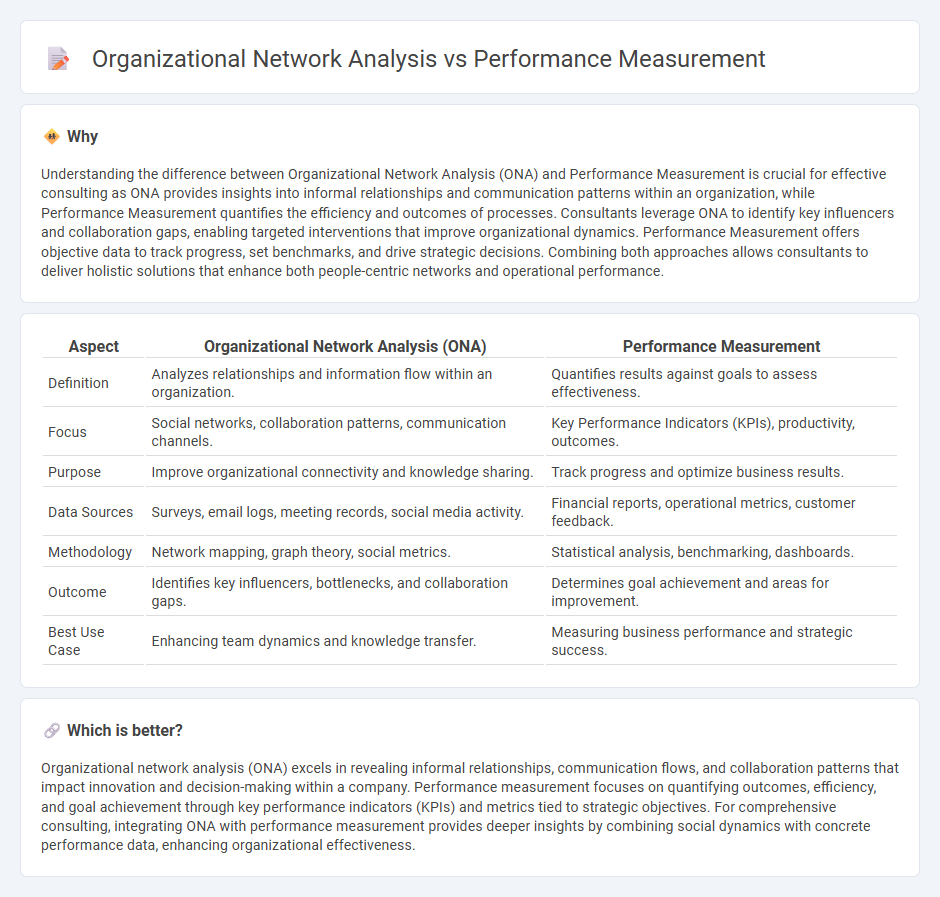
Organizational Network Analysis (ONA) maps the relationships and communication patterns within a company to identify key influencers and collaboration bottlenecks. Performance measurement evaluates specific outcomes such as productivity, efficiency, and goal attainment to assess overall organizational effectiveness. Explore how integrating ONA with performance measurement can drive strategic consulting insights and improve business results.
Why it is important
Understanding the difference between Organizational Network Analysis (ONA) and Performance Measurement is crucial for effective consulting as ONA provides insights into informal relationships and communication patterns within an organization, while Performance Measurement quantifies the efficiency and outcomes of processes. Consultants leverage ONA to identify key influencers and collaboration gaps, enabling targeted interventions that improve organizational dynamics. Performance Measurement offers objective data to track progress, set benchmarks, and drive strategic decisions. Combining both approaches allows consultants to deliver holistic solutions that enhance both people-centric networks and operational performance.
Comparison Table
| Aspect | Organizational Network Analysis (ONA) | Performance Measurement |
|---|---|---|
| Definition | Analyzes relationships and information flow within an organization. | Quantifies results against goals to assess effectiveness. |
| Focus | Social networks, collaboration patterns, communication channels. | Key Performance Indicators (KPIs), productivity, outcomes. |
| Purpose | Improve organizational connectivity and knowledge sharing. | Track progress and optimize business results. |
| Data Sources | Surveys, email logs, meeting records, social media activity. | Financial reports, operational metrics, customer feedback. |
| Methodology | Network mapping, graph theory, social metrics. | Statistical analysis, benchmarking, dashboards. |
| Outcome | Identifies key influencers, bottlenecks, and collaboration gaps. | Determines goal achievement and areas for improvement. |
| Best Use Case | Enhancing team dynamics and knowledge transfer. | Measuring business performance and strategic success. |
Which is better?
Organizational network analysis (ONA) excels in revealing informal relationships, communication flows, and collaboration patterns that impact innovation and decision-making within a company. Performance measurement focuses on quantifying outcomes, efficiency, and goal achievement through key performance indicators (KPIs) and metrics tied to strategic objectives. For comprehensive consulting, integrating ONA with performance measurement provides deeper insights by combining social dynamics with concrete performance data, enhancing organizational effectiveness.
Connection
Organizational network analysis (ONA) maps and measures relationships and information flow within a company, directly influencing performance measurement by identifying key influencers, collaboration bottlenecks, and communication patterns. By leveraging ONA insights, consultants can develop targeted strategies that enhance employee engagement, knowledge sharing, and operational efficiency, resulting in improved key performance indicators (KPIs). This data-driven approach enables organizations to align social network structures with business goals, optimizing overall performance outcomes.
Key Terms
Key Performance Indicators (KPIs)
Performance measurement centers on evaluating Key Performance Indicators (KPIs) to assess organizational efficiency, productivity, and goal achievement through quantitative data analysis. Organizational network analysis (ONA) examines informal relationships and information flow within a company, revealing how social connections impact knowledge sharing and collaboration, which are critical but less tangible KPIs. Explore these methodologies further to understand how integrating performance metrics with network dynamics can enhance strategic decision-making.
Social Network Mapping
Social Network Mapping in Organizational Network Analysis provides detailed visualization of relationships and interactions within a company, highlighting communication patterns and informal structures often overlooked by traditional Performance Measurement systems. While Performance Measurement focuses on quantifiable metrics like KPIs, productivity, and financial outcomes, Social Network Mapping uncovers collaboration dynamics and influence pathways that drive organizational effectiveness. Explore how combining these approaches can enhance strategic decision-making and operational efficiency.
Benchmarking
Performance measurement utilizes key performance indicators (KPIs) to benchmark organizational efficiency, productivity, and goal achievement against industry standards. Organizational network analysis (ONA) maps formal and informal communication patterns, revealing collaboration bottlenecks and influential employees that impact benchmarking outcomes. Explore how integrating performance measurement with ONA enhances benchmarking accuracy and strategic decision-making.
Source and External Links
Performance Measurement - What Is It, Example, Methods, Types - Performance measurement is a process of quantifying and assessing the effectiveness and efficiency of an organization or individual in achieving their goals using methods such as KPIs, Balanced Scorecard, Six Sigma, performance appraisals, customer satisfaction surveys, benchmarking, and ROI.
Performance measurement - Wikipedia - Performance measurement involves collecting, analyzing, and reporting information on the performance of individuals, groups, or organizations with definitions focusing on management evaluation, efficiency, and results attainment.
Effective performance measurement: Key to business growth - Performance measurement is essential for benchmarking against competitors, identifying competitive advantages, aligning business goals with metrics, driving organizational focus, and adapting strategies to market changes.
 dowidth.com
dowidth.com